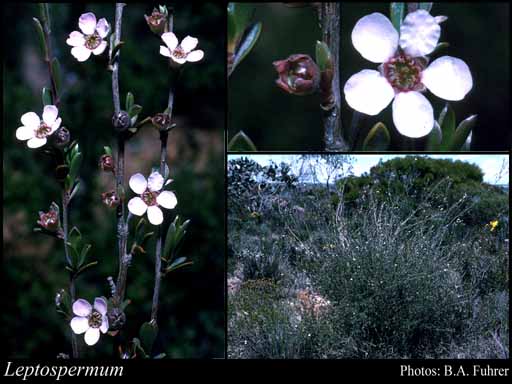- Reference
- Char.Gen.Pl. Edn. 2:71, Tab. 36 (1775)
- Name Status
- Current







Scientific Description
Common name. Teatrees. Family Myrtaceae.
Habit and leaf form. Shrubs, or trees (with smooth and flaking, fibrous or papery bark); evergreen; bearing essential oils. Plants with neither basal nor terminal concentrations of leaves. Young stems with or without stem ‘flanges’, membranes extending each side of the leaf base and sometimes continuing for some distance down the stem. To 0.3–20 m high. Leptocaul. Helophytic to xerophytic. Leaves minute to medium-sized; alternate; spiral; ‘herbaceous’, or leathery; petiolate, or subsessile, or sessile; gland-dotted; aromatic (occasionally lemon-scented); with ‘normal’ orientation; simple; epulvinate. Leaf blades dorsiventral, or isobilateral, or centric; entire; flat; linear, or lanceolate, or oblong, or ovate; linear, or ovate, or obovate, or elliptic; pinnately veined, or parallel-veined, or one-veined; cross-venulate. Mature leaf blades adaxially glabrous; abaxially glabrous, or pubescent. Leaves with stipules (stipules minute and usually seen only about the flowers). Leaf blade margins entire. Leaves without a persistent basal meristem. Stem anatomy. Secondary thickening developing from a conventional cambial ring.
Reproductive type, pollination. Fertile flowers hermaphrodite, or functionally male. Unisexual flowers present, or absent. Plants hermaphrodite, or andromonoecious. Male flowers with pistillodes (style reduced or stigma sessile), or without pistillodes (style and stigma absent). Entomophilous, or ornithophilous. Pollination mechanism unspecialized.
Inflorescence and flower features. Flowers solitary, or aggregated in ‘inflorescences’; axillary (on condensed shoots). The terminal inflorescence unit cymose. Inflorescences axillary; monads in leaf axils. Flowers pedicellate to sessile; bracteate. Bracts deciduous. Flowers (bi) bracteolate. Bracteoles deciduous. Bracteoles not adnate to the receptacle. Flowers small to medium-sized; regular; 5 merous; cyclic. Free hypanthium present (petals ‘inserted on the calyx’); usually campanulate; extending beyond ovary (where it is very much expanded); fused to ovary wall. Perianth with distinct calyx and corolla; 10; 2 -whorled; isomerous. Calyx present; 5; 1 -whorled; polysepalous; imbricate; exceeded by the corolla; more or less membranous or scarious at least towards the margins; persistent, or not persistent. Sepals oblong, or ovate, or triangular. Corolla present; 5; 1 -whorled; polypetalous; imbricate; regular; plain, or with contrasting markings; white, or pink, or white and pink, or red; deciduous. Petals obovate, or orbicular; clawed, or sessile. Androecial members definite in number, or indefinite in number. Androecium 5–55. Androecial members branched, or unbranched. Androecial sequence determinable, or not determinable. Androecial members if ‘many’, maturing centripetally; free of the perianth; all equal, or markedly unequal; free of one another (ostensibly, the stamens being spread evenly around the hypanthium rim), or coherent (really indistinctly bundled, the groups indicated in fresh material by curvature of the filaments); 5 - adelphous ((if considered as bundled)). The androecial groups opposite the petals. Androecial members 1 -whorled. Stamens 5–55; attached on the rim of the hypanthium; becoming exserted (usually shorter than the petals); all more or less similar in shape; isomerous with the perianth to polystemonous; alternisepalous and oppositisepalous; both opposite and alternating with the corolla members; inflexed in bud (incurved towards the stigma). Filaments not geniculate; glabrous (usually), or hairy; filiform. Anthers all alike; dorsifixed; versatile; dehiscing via longitudinal slits; introrse; tetrasporangiate; appendaged (with a prominent gland near the connective and a thickened area at the base of each cell). Fertile gynoecium present, or absent (male flowers). Gynoecium 2–12 carpelled. The pistil 2–12 celled. Gynoecium syncarpous; eu-syncarpous; inferior. Ovary plurilocular; (2–)3–10(–12) locular. Ovary summit glabrous, or hairy, the hairs not confined to radiating bands. Epigynous disk present. Gynoecium stylate. Styles 1; simple; attenuate from the ovary, or from a depression at the top of the ovary; apical. Stigmas 1; capitate, or peltate. Placentation axile. Ovules 4–200 per locule; pendulous to horizontal, or ascending ((rarely) in the peltate placenta, which is usually attached just above the middle of the central axis); in 2–12 vertical rows; non-arillate; anatropous.
Fruit and seed features. Fruit stipitate to sessile; falling from the plant before the next growing season, or persistent; fleshy, or non-fleshy; dehiscent; a capsule (with 2-many, woody or non-woody valves). Capsules loculicidal. Fruit several to many seeded. Seeds several to many per locule. Seeds non-endospermic; ovate or irregularly linear; minute to small; winged (the wing formed from extended marginal cells on the seed surface), or wingless. Cotyledons 2. Testa reticulate or striate.
Geography, cytology, number of species. Native of Australia. Not endemic to Australia. Australian states and territories: Western Australia, South Australia, Northern Territory, Queensland, New South Wales, Victoria, Australian Capital Territory, and Tasmania. Northern Botanical Province, Eremaean Botanical Province, and South-West Botanical Province. 2n=22 and 2n=44.
Etymology. From the Greek for "thin, slender" and "seed".
Taxonomic Literature
- Wheeler, Judy; Marchant, Neville; Lewington, Margaret; Graham, Lorraine 2002. Flora of the south west, Bunbury, Augusta, Denmark. Volume 2, dicotyledons. Australian Biological Resources Study.. Canberra..
- Wheeler, J. R.; Rye, B. L.; Koch, B. L.; Wilson, A. J. G.; Western Australian Herbarium 1992. Flora of the Kimberley region. Western Australian Herbarium.. Como, W.A..
- Thompson, Joy 1989. A revision of the genus Leptospermum (Myrtaceae).
- Marchant, N. G.; Wheeler, J. R.; Rye, B. L.; Bennett, E. M.; Lander, N. S.; Macfarlane, T. D.; Western Australian Herbarium 1987. Flora of the Perth region. Part one. Western Australian Herbarium.. [Perth]..